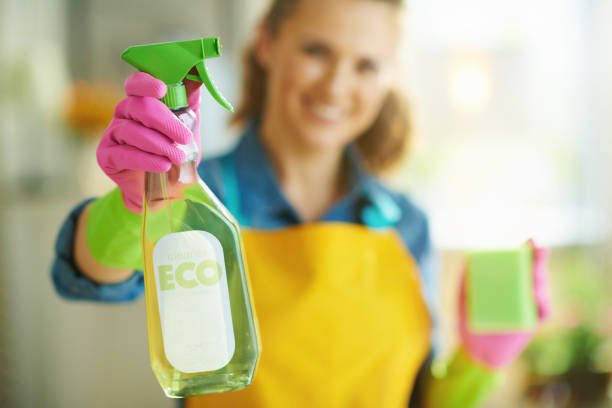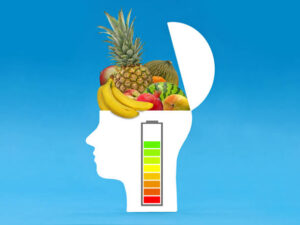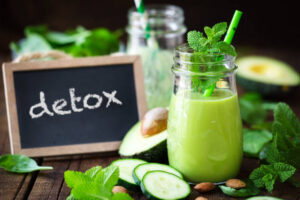When you have a busy schedule, keeping your house clean can seem like a constant chore. Getting the job done quickly and effectively requires the right cleaning supplies. You can choose from dozens of cleaning products at the store when browsing the aisles. Unfortunately, many cleaning supplies are harmful to your health and the environment.
With only a few basic supplies, you can make many zero waste cleaning products. Additionally, eco-friendly cleaning is much more affordable than conventional cleaning. Each room will be cleaned with the right cleaning tools and with the best organic cleaning products.
Zero Waste Cleaning Products: Why Make Your Own?

Using zero waste cleaning supplies when cleaning your home makes things easier and greener. Here are some reasons why:
-
- You will be able to prevent toxic chemicals from entering your home or being released into the environment.
-
- Your carbon footprint will be reduced as you will buy less and travel less to get them.
-
- Zero waste cleaning products can help you reduce your household plastic consumption (which can end up in oceans and destroy marine life because they cannot be recycled, and even when they are recyclable, they are often not disposed of properly).
-
- Natural cleaning products can be better for cleaning and washing clothes if you or anyone in your family has sensitive skin.
-
- You can also save a lot of money by making your cleaning products.
-
- In addition, zero waste cleaning products are fun to make!
Problems with Regular Cleaning Products

In many household products, manufacturers fail to disclose all ingredients, which can irritate your lungs, eyes, or skin. Every time you wash clothes, sponges, or brushes made of plastic, microplastic pollution enters the waterway. Although single-use paper towels don’t contain plastic, they contribute to landfill waste and deforestation.
There’s good news though: you can make your zero waste cleaning products that are good for the environment and for you. You don’t need to spend much time or effort preparing it. Clean your home without polluting the environment with DIY solutions that take just minutes and common household ingredients.
Why Opt For Zero Waste Cleaning Products

-
- Your wallet, health, and the environment will all benefit from turning to a zero-waste cleaning routine.
-
- Because of their synthetic fragrances, toxic compounds (which produce smog), and other toxic ingredients, most conventional cleaning products are irritating to the nose and throat. That’s gross!
-
- Unlike non-biodegradable cleaners, most conventional cleaners come in plastic packaging and don’t decompose naturally.
-
- If the cleaning products we use are toxic and unable to decompose, then why do we use them in our waterways and natural environments?
Read more on the Top Reasons to Switch to Eco-Friendly Cleaning Products here
Basic Ingredients of Zero Waste Cleaning Products

Making zero-waste cleaning supplies is usually as easy as gathering a few readily available, toxic-free ingredients and cooking them up. You can make them using simple, natural ingredients commonly found in supermarkets or stores instead of off-the-shelf products that contain chemicals and compounds.
Moreover, they are powerful enough to handle several different cleaning tasks, ranging from washing dishes to mopping floors except for the most demanding applications. When creating your zero-waste cleaning products, these ingredients will give you a strong foundation.
- Alcohol: The antiseptic and bactericidal properties of alcohol make it an excellent ingredient for zero waste cleaning supplies. Additionally, its fast evaporation times make it ideal for cleaning glass and other surfaces.
-
- Crystallized soda: Soda crystals make excellent DIY cleaning ingredients because of their naturally occurring chemical makeup. Most zero-waste cleaning recipes call for washing soda or baking soda, but percarbonate or even borax are also natural components – although they should be used with caution.
-
- Essential oils: A wide variety of different oils can be used in your DIY zero-waste recipes to add natural fragrances. It’s important to keep in mind that certain oils have other beneficial properties as well. Orange oil offers excellent antiseptic properties, while tea tree oil is a natural degreaser.
-
- Vinegar: The acetic acid in vinegar provides anti-bacterial properties, as well as the capability of dissolving mineral deposits, dirt, grease, and grime.
-
- Bar soap (Castille soap): The Castille soap originated in Spain and is based on vegetable oil. Vegans can use it because it contains no animal products and has excellent cleaning properties in any application.
-
- Distilled water: Glass cleaning spray should be made with distilled water. Because it’s purified, it leaves fewer streaks and spots. To save on packaging waste, buy bulk distilled water.
-
- Hydrogen Peroxide: Adding oxygen to water results in hydrogen peroxide. As an alternative to chlorine bleach, it disinfects and fights germs.
-
- Cornstarch: We use cornstarch to make our streak-free glass cleaner! You might be surprised to hear that! In addition to removing dirt and fingerprints, it leaves no residue behind.
Be sure to read these tips before you get started:
- Vinegar and Castile soap should not be mixed. In combination, Castile soap and vinegar are less effective since they are acidic and basic, respectively.
-
- When using new cleaners, always test them on an inconspicuous surface first.
-
- If you want to avoid spills when filling bottles, use a funnel.
-
- Make sure homemade cleaners are clearly labeled.
-
- Avoid cross-contamination by using clean, non-chemical bottles.
Best DIY Zero Waste Cleaning Products Recipes

1. A multipurpose cleaner
With 15-20 drops of essential oil in a spray bottle, mix equal parts vinegar and water.
Suitable for: Almost any surface in your house! However, do not use this product on marble or granite.
2. Gunk cleaner
An equal amount of olive oil and baking soda is required. Allow to sit for a couple of hours before wiping off.
Suitable for: Getting rid of labels from jars!
3. Cleaners for stainless steel
A cloth dipped in olive oil can be used to wipe away smudges. Wipe over the same spots with a clean cloth dampened with vinegar.
Suitable for: Appliances made of stainless steel. Say goodbye to smudges!
4. Mold cleanser
Make a paste of baking soda and water. Wait a few minutes before applying to the surface. Scrub with an old toothbrush or scrubber.
Suitable for: Drain cleaning and grout cleaning!
5. A multipurpose scour
One and two-thirds cups baking soda, one and a half cups liquid castile soap, and one and a half cups of water. Make sure that the ingredients are well mixed and store them in an airtight container.
Suitable for: Tiles, sinks, and the bathtub!
6. Chopping board cleaner
Take advantage of lemons! To clean, disinfect, and deodorize your cutting board, cut a lemon in half and rub the cut side into it. Dry with a towel after rinsing.
Suitable for: Chopping boards!
7. Cleanser for toilet bowls
Hydrogen peroxide can be used in your toilet bowl for 30 minutes by using half a cup. You can clean your toilet bowl with a toilet bowl brush.
Suitable for: Cleaning toilet bowls!
8. Window and glass cleaner
In a spray bottle, mix vinegar with water evenly. Use a reusable cloth to spray and wipe.
Suitable for: Windows and doors made of glass.
Tips on Using Zero Waste Cleaning Supplies
- Make cleaning easier by repurposing old toothbrushes
-
- Make sure you use scrub brushes made from materials that will decompose and biodegrade, such as wood.
-
- Buy a set of reusable cleaning cloths or use rags made from old clothes
-
- Use Swedish sponges to clean
-
- Copper or other abrasive materials can be used to scrub
-
- Wear rubber gloves to clean
-
- In that case, buy a large container size in an amount you know you will use if you can’t find refillable ingredients like vinegar or hydrogen peroxide.
-
- Don’t know what to do with old cleaning supplies? You might be able to donate them to a local charity or friends if they can use them.
-
- Most people spend 87% of their time indoors, according to studies. Therefore, your indoor space must have high air quality. Keep your home clean by dusting and vacuuming frequently.
Most people spend 87% of their time indoors, according to studies. Therefore, your indoor space must have high air quality. Keep your home clean by dusting and vacuuming frequently.
Buying Zero Waste Cleaning Tools

Take a look at the cleaning tools you use: dish sponges, plastic toilet brushes, and paper towels. Thousands of them are thrown away every year once they’re no longer useful or overused and replaced over and over again.
-
- Rags:
Wipe up dust or other messes with these instead of feather dusters. Towels made from 100% cotton are my favorite. Their ability to absorb liquid and pick up dust is excellent. They take a long time to wear out, making them a great reusable cleaning product.
-
- Feather duster:
It is certainly possible to find a feather duster that is plastic-free. The majority of non-plastic feather dusters have wooden handles and ostrich feathers. Second-hand items are already available, and you’ll prevent landfill waste by keeping them out. Vacuum up feather dust afterward if you feel feather dusters just move dust around.
-
- Cleaning spray:
It can be used on any area and in any room, and it is versatile enough to be used anywhere. In addition to cleaning sinks, windows, mirrors, and countertops, it can also be used to wash cars.
-
- Scrubs:
A bamboo dish brush lasts a very long time, which is one of the reasons I like them. I use a pot brush on tiles and tubs, for example, and a bamboo bottle brush for my bottle. After their useful lives are over, they are easy to compost.
-
- Dust pans and wooden brooms:
Hand brooms and metal dustpans can be used to clean up small spills; you must mot break the vacuum. I recommend checking out an antique mall if you’re need a similar solution. Mine are both secondhand.
How Effective are DIY Zero Waste Cleaning Products?

It is common for people to be skeptical about the effectiveness of DIY cleaning products. They believe that commercial products have a higher power and reliability. Follow sustainable shopping tips to ensure that the items you get are safe for you and the environment. Do your research, not simply rely on marketing claims.
Making your cleaning supplies can, however, be just as effective as buying them in a store if not more so. In many DIY cleaning solutions, vinegar and baking soda are used to remove tough stains.
Aside from their natural antibacterial properties, essential oils can also be used as a natural way to prevent infections without having to use harmful chemical disinfectants. As a result, they are excellent natural disinfectants.
You can keep your home clean and germ-free naturally and affordably with DIY zero waste cleaning supplies, as well as reduce your exposure to potentially harmful substances.
Conclusion
Sustainable living involves more than just considering your purchases carefully but also reducing your overall consumption to ensure a circular economy. Several ways can be taken to accomplish this, including growing your food, learning traditional skills, and making rather than buying zero waste cleaning products.
It can take time to switch to zero waste cleaning supplies – and you won’t always achieve perfection. It’s important to make informed decisions and to do your best. You can make a big difference for your family and community by practicing zero waste cleaning even on a small scale.







